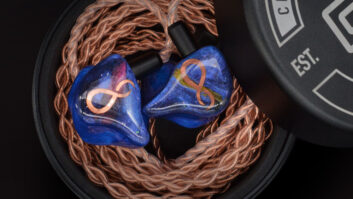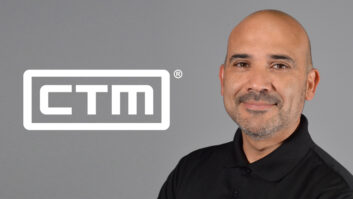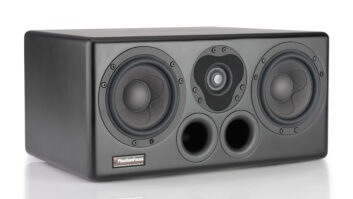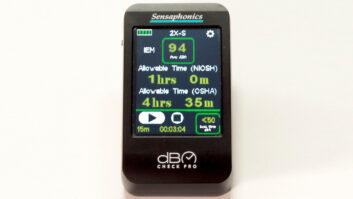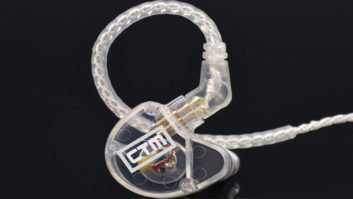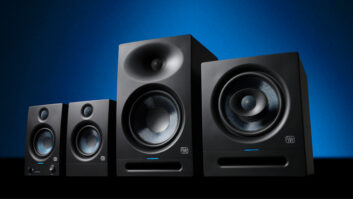In-ear monitors are not just for rock stars and Platinum cowboys anymore. The miniature speakers that fit in musicians’ ears are gaining popularity, and today more and more tours are leaving floor monitors and sidefills back in the shop. Advances in IEM products have combined with their economic benefits to encourage more bands to move over to better-sounding, safer stage monitoring. We spoke with a half-dozen leading engineers who have worked with IEMs for many years about how to make the switch.
BEFORE YOU START
Everyone we spoke with agrees that the first step is a discussion among bandmembers about the benefits of in-ear monitors and the experience of changing over. The monitor operator needs to first do a little research and find out about available equipment and how to apply it to the artist’s particular situation. Larry Droppa, the IEM pioneer who works with Stevie Wonder, advises that the monitor engineer take a leadership role early on, discussing the pros and cons with the artist and acting as ambassador for the technology. Dave Pallett, who started Sarah McLachlan on IEMs four years ago, says it’s important to check that no one is really opposed to it. Drummers and vocalists tend to benefit most from IEMs and are usually willing to make the switch, but guitar players, who are used to creating a pocket of sound they can step in and out of, often offer resistance. Jerry Harvey, designer of the UE-5 earpiece, who just finished touring with Van Halen, agrees, adding, “If the band is willing to try, I’d first tell them how it’s going to be different-not just the isolation, but also the benefits of monitoring yourself more clearly.” He suggests everyone try it for a couple of soundchecks before making a decision. “Until you try it, you won’t know how much tighter your playing can be.”
“You have to start with the earpiece, the same way people used to get together and listen to wedges when they started a tour,” says Droppa. Pallett recommends seeking advice on earpieces before making purchases for the entire band. “The problem is that you can’t really try custom molds unless you just go ahead and buy them,” Pallett explains. “Research different models and talk to people who have tried them.” He points out that Walkman-type earbuds don’t provide enough isolation unless the stage is quiet, in which case you don’t need them anyway. “What you’ll find, given a half-dozen models, are six different sounds,” Droppa adds. “Most people don’t have that luxury and must rely on the recommendation of someone that already has a pair.” He suggests first listening to a CD player or home stereo for a few weeks to get used to what they sound and feel like.
Rob Nevalienen, who has mixed IEMs for Stephen Curtis Chapman, Luis Miguel and Styx, suggests getting your feet wet by bringing your molds to wedge gigs before your band makes the switch. “Engineers can plug into a console’s headphone output and get a feel for what individual inputs sound like with the earpiece’s isolation.” Before you put it in a musician’s ears, you should try it yourself and learn the limitations and what you can do to sweeten it up in a mix.
Steve McCale, who mixes “ears” for the Steve Miller Band, suggests practicing by making stereo headphone mixes before introducing the technology to the band. “Then one day you can run a cable onto the stage at soundcheck to let the guys try monitoring with a pair of good closed headphones before they’ve even spent a dime,” explains McCale.
MAKING THE TRANSISTION
Using IEMs in rehearsal gives a band the chance to try them without the pressure of a gig. “Find a rehearsal space that you can rent out cheap and play for a while,” suggests Ian Kuhn who’s mixed IEMs for the Dave Matthews Band for several years. “Time and again I’ve seen bands jump into it before a show, and they’re the ones that have more problems.” Pallett agrees that it can be awkward to work them in on- the-fly while touring. For bands already out doing shows, Harvey suggests making the transition with one member each day to give them the proper attention. “In the real world, this stuff shows up in boxes at the gig and you’ve got to try to work with one person at a time.”
“I recommend an all-or-nothing approach because hybrid monitor systems are more difficult,” says McCale. He insists on getting rid of the wedges and minimizing ambient stage sound from the backline so the new approach has a chance to show what it can do, though using a woofer or bass rig to add sub-lows to the drums or bass can be helpful. “Make sure each mix is together before you hand it to each musician, because they won’t have the patience to listen while you learn,” McCale points out. “Get the mixes started during line-check and then begin with the drummer, adding one musician at a time until everyone’s rocking with a killer instrumental mix.” He advises bringing in vocalists last, but not until their mix is ready, with a big, fat, wet sound so they can have a positive first impression.
PROCESSING REQUIREMENTS
Mixing IEMs differs from wedges. You have to be more accurate with the mix, but you’re no longer managing feedback with EQ at the expense of sound quality. Outboard equipment for in-ear monitors is a typical FOH complement of gates, compressors and effects. In reality it’s more like mixing for broadcast. “It’s like doing a remote mix because you’re kind of removed from the listening environment,” Nevalienen explains. “You have to add ‘size’ back to the mix with reverb and audience mics, but you also have to squash the dynamic range to keep things from jumping out, especially on vocals and guitars, which you wouldn’t normally do with wedges.”
“Any featured vocal mics must have a compressor inserted, using high thresholds with high ratios,” McCale advises. The vocal is often the loudest element of the mix and the most dynamic, so if you don’t limit it individually, every time it peaks, the whole mix is going to pump and breathe as it hits the master limiter. Compression on bass, kick, snare or drum machines allows more overall level, because it’s easy to clip a mix. “You also need mix compression because the built-in limiters are a little too stiff,” Harvey cautions. “You need them for protection, but you don’t want to run into them more than a few dB.” Droppa emphasizes that mixing IEMs is not the same as wedges. “As the mix keeps building, you reach a point where you can only put more of something in by taking other things down,” he cautions.
Each singer’s vocal is usually panned to the center in his or her own mix. “A little reverb or chorus-reverb adds dimension to the vocal, making it clearer and easier to hear,” McCale explains. “I like a Harmonizer with a few cents of shift to spread it out. It’s not like you have to sauce up the guitars, but a little ambience on the drums makes a world of difference.”
Rather than a static wedge mix, you’re going to be doing a full mix, pushing cues and making fader moves that mirror what’s going on at FOH. “You definitely need to actively mix the show,” Harvey says. “You’ll be riding solos and pushing up singers when they’re quiet.” He also points out that there are details to how the mixes are structured, and some individuals will prefer a static mix to the fader moves. “There’s going to be bandmembers that are pre-fader on many inputs, like drummers, while others are post-fader,” Harvey continues. “The down-center star will want to hear all the cues, but the guy playing rhythm guitar won’t want to hear the lead guitar come up whenever there’s a solo.”
Essentially, you end up mixing a record every night. “FOH engineers have the most applicable skills,” McCale comments, “and have the easiest time making the transition to being an IEM engineer.” For a frustrated monitor engineer who would rather be mixing house, IEMs can be a welcome relief. With ear monitors you’re concerned with image, tone and definition instead of feedback, which is a lot more fun-you get to mix music instead of just getting the voice loud. McCale points out that the pan pot becomes important. “The difference between having something located at 1 o’clock or at 3 o’clock in your head can make more difference than 6 dB of level change,” he adds.
Minimal equalization of mixes is helpful but not necessary, and the parametric output EQ on several consoles is considered more than enough. “A standard graphic works if parametrics aren’t available,” Harvey says. “There’s often three points of EQ that can help. Wide, rather than narrow filters work better.” He suggests boosting 100 Hz, cutting around 3 kHz and then maybe a wider cut around 5 kHz to make the highs above that stand out. “RF systems don’t like high-frequency boost-it freaks out the transmitter,” Harvey adds, pointing out that most wireless systems include a built-in high-frequency boost to counter the transducer’s roll-off. “It’s better to use the belt-pack’s built-in boost for sibilance along with cuts to keep it from getting harsh.”
AMBIENCE MICS
In addition to needing as many inputs as the FOH desk, a monitor desk must also have enough inputs for ambience mics, which pick up the audience and the room. “Audience mics help ease the transition for artists by giving them the crowd’s reaction,” Nevalienen comments, while Kuhn points out that “the right combination of ambient mics can be better than reverb effects. I rely on the natural reverb of the room, although for quiet songs it’s nice to add some reverb to the snare.” Kuhn also finds that he gets a lot of useful room ambience from the drum overheads. Harvey finds that monitor mixes inevitably contain ambience from the drum overheads and open vocal mics. “But it’s not the same as properly placed, dedicated room mics,” he notes.
Locating a pair of ambience mics in neutral spots downstage out of the P.A.’s pattern on each side of the artist replicates the sound they would hear naturally and helps to identify individuals in the audience. “I always make sure the ambience mics are on before the artist puts on their ears so they never feel isolated,” reports McCale. A pair of pencil condensers like SM-81s or C-460s are commonly used, but nearly everyone cited something like a Sennheiser 416 short shotgun as their preference. Droppa agrees that ambience mics are essential but notes that some artists like to be in a closed-off environment, more like a studio headphone mix.
CHOOSING EAR MOLDS AND ‘PHONES
The two kinds of transducers used inside the various earpieces are the diaphragm-type found in Walkman ear-buds and the armature-type found in hearing aids. The diaphragm-type is ported to tune the low end and therefore allows more ambient sound into the ear, but the improvement in bass response is at the expense of highs. The armature-based transducers have more highs, but often peak around 3 kHz, where hearing impairment generally first occurs. Two-way earpieces, like high-fidelity speakers, use two transducers, each optimized for the frequency range they’re intended to cover, allowing higher headroom, better frequency response and lower distortion. (For a detailed look at available ear pieces, refer to “Choosing In-Ear Monitors”, in the July 1997 issue of Mix.)
“I own 15 or more different models of earphones, and the high-end dual-transducer molds make a huge difference,” Nevalienen points out. “It’s like comparing the factory in-dash speakers in your car to the two-way speakers you’d replace them with.” He suggests using the same model as the band-members for accurate monitoring. “If a band is financially able, I suggest they dive right in with top-of-the-line custom molds,” Kuhn agrees. “A proper fit often makes a big difference in sound quality and comfort, giving the best impression of this technology’s ability.” The ability to monitor at safe levels is only possible with earpieces that offer isolation from stage noise. “If you’ve got your ear mix going full-blast to get over the stage level, then you’re more than likely damaging your hearing,” Nevalienen adds. “Whatever products you choose, get as much isolation as possible.”
SHORTCUTS. CAN MONO WORK? MUST IT BE WIRELESS?
When set up for stereo, IEMs will require almost twice as many outputs from the monitor desk as wedges, plus additional sends and returns for reverb. A band that was happy with four wedge mixes may wind up with a dozen IEM outputs, plus an additional drummer’s send for subwoofers or “shakers” that can produce the low-frequency impact that the IEM transducers can’t deliver.
If the number of buses on the monitor console is limited, only mono mixes may be possible at first. Though a mono mix has more clarity than a wedge, without stereo you can’t get the benefit of centering the artist while panning other inputs around to create space. “We live in a stereo world, and that dimension keeps you in touch with what’s going on,” Droppa says. “By the time you get an entire band’s worth of inputs piled up, you have difficulty maintaining distinction between instruments.”
Most engineers insist on stereo mixes. “You get so much from the stereo field you listen to naturally that when you’re in mono it sounds alien,” McCale points out. “If you listen to similar inputs in mono, it’s hard to tell one from the next, but when they’re panned, it’s easier and you can even turn down the volume.” If you can’t afford limiters, reverbs or wireless, at least make sure everyone has stereo mixes. “I’d prefer stereo even if it meant giving up effects sends,” Nevalienen agrees, though he advises keeping at least one aux bus free for vocal effects. “You can send to a reverb from a direct out, but on many consoles they’re pre-fade, so they don’t work well for vocals.”
Shortcuts for dedicated effects include using direct outs or inserting on input channels, and aux bus inputs can be used as effects returns. “You could insert on a snare or an acoustic guitar-any single instrument that needs reverb,” Harvey proposes. Similarly you can take a direct out for the kick and bass DI to send to subwoofers between those two players. McCale doesn’t recommend running the entire mix through a reverb, though: “You wouldn’t want the same effect on everything, because some inputs need to be dry and tight.”
Just as with wedges, it’s hard for vocalists to share a mix. Two musicians can sometimes share a stereo mix, which is better than each having a mono mix because by panning inputs, they’ll both get a better sound field. “More than two is difficult, but I could see a bass player and drummer sharing, or two rhythm players,” McCale offers.
Everyone agreed that hard-wired systems generally have better sound, lower cost and less potential RF problems than wireless. Harvey points out that with wireless you only get partial stereo separation. “You only get 9 o’clock and 3 o’clock, instead of hard left and right,” he notes. Though standard headphone amps can be used, hard-wire beltpacks are less likely to blow up the earpieces and allow musicians to adjust their own volume. Drummers can go hard-wire, but anyone who moves around needs wireless. Money saved on the drummer’s hard-wire tends to get spent on a subwoofer or drum-throne shaker for added impact. Even with a protection limiter and custom molds, IEMs costs less than the wedges and amps they replace, but the full advantages require a dedicated console that travels with the band.
IEM ADVANTAGES
IEMs can lower sound exposure and help conserve hearing because individuals no longer have to compete to hear themselves over others. Besides the obvious advantage of effectively eliminating feedback, IEMs can reduce vocal fatigue, particularly on tours with multiple consecutive gigs. And IEMs allow more accurate monitoring. “Every musician who has made the switch says it’s a more musical experience,” Nevalienen comments. “They can hear themselves and the entire performance more clearly, and become more excited about playing.” McCale says that when the band can hear better, they play tighter and sing better, and this all translates into better paychecks and longer careers.
Though it’s often difficult for the monitor engineer to tell what an artist’s stage wedge really sounds like, IEMs will reproduce the mix with consistency and accuracy. Further, a wireless system mix will follow a musician all over the stage without any significant change-musicians who know their way around a mixing board can walk right over and fix their own mixes during soundcheck without disturbing the monitor guy, who may be busy catering to the star. “Musicians will more easily be able to hear what they want and they’ll have more fun,” says McCale. There are also unique communication possibilities with artists able to talk to their engineers or each other without being overheard by the audience. Changing the set list mid-show can be as easy as whispering into a talkback mic.
Night-to-night consistency is another significant benefit. “After you have the band happy in rehearsal, when they step out onstage, no matter what size the venue, they still have the same sound,” explains Harvey. Besides the possibility of eliminating soundcheck, often a requirement in festival situations, opening acts may find it easy to carry a small rig that’s dialed up and ready to go. Some bands have found they can carry a complete monitor rig in the cargo bay of the bus and, short of the console, can more easily ship it overseas.
There are uses for IEMs offstage as well. An in-ear system can effectively replace a rehearsal monitor system, reducing the impact of band practice on the neighbors, and vice versa. Several interviewees also mentioned the recent trend among IEM-aware musicians who bring their IEMs into the studio. “It may seem like it costs more up front to get into in-ear monitors, but in the long run it can save time and money, in addition to hearing,” McCale points out. Add to all this the potential for a cleaner, clearer concert experience for the audience as the stage volume is reduced and the FOH engineer is given more control of the show, and you have a winner.
AVOIDING THE PITFALLS
Before we leave you thinking that everything’s rosy with IEMs, there are some possible pitfalls to be considered. Switching to IEMs will not automatically result in lower SPLs for the musicians, for example. “Saving your hearing is not just a given,” Pallett cautions. “Some people just like it loud, and they’ll get their guy to turn it up just as loud as wedges.” Harvey adds that you must know when your artist is abusing his or her hearing-it’s your job to tell them when it’s too loud. “It’s the artist’s decision from that point, but your job is to inform your clients when they’re hurting themselves,” he adds. Each day Harvey compares his own hard-wired reference against the musicians’ systems, establishing a reference point on the beltpack’s dial that sets a comfortable, safe level. If they’re turning themselves up from there, it’s a reason to discuss what needs aren’t being met in their mix.
“Another problem is that vocalists can hear themselves so clearly that they back off the mic and only put out half their normal volume,” Harvey continues. “It’s important to set mixes so that singers still have to push a little to get on top and the FOH engineer can get enough level.” Another common problem with ear monitor systems is that instruments that leak into open vocal or drum mics can sound indistinct, and many close-miked inputs may be needed to overcome this ambience in the mix.
Continuing to push up levels is a pitfall that Droppa highlights, advising: “You need to understand how an RF system works.” Since individual mixes are not competing with each other as with wedges, levels are managed differently. “You need to run the mix at a high level without overloading it, so that the residual noise of the system is minimized, but then as you add more to the mix, the overall level has to come down.”
Finally, an IEM system requires a competent operator, someone who can make the sound better, not just louder. McCale recommends against getting into IEMs before the band is at a point where it can lease or buy their console, or has an engineer that can get consistency out of local production. “Mixing in-ears is a skill that requires some practice and training,” McCale warns. “Your monitor engineer has to be on the ball, because when it’s wrong, it can be a show-stopper.”
WIRELESS IEMS FOR CUEING AND COMMUNICATION
While mixing monitors for k.d. lang last year, I started using in-ear monitors instead of a traditional cue wedge and have discovered several advantages. For example, at the beginning of the show, k.d. could easily turn her back to the audience for a moment and whisper comments into her microphone that only I heard, eliminating the frustration of hand signals. Another benefit of IEMs is that incipient feedback can be heard before it actually goes into oscillation.
A wireless IEM system switched to mono mode allows two inputs to be mixed together. This enables one to combine the monitor console’s “cue” output with the intercom system, a setup that can speed communications, especially during soundcheck. The FOH engineer can speak to me immediately, wherever I am onstage, without having to wait for me to notice the intercom call light. Often, only a hand signal is needed in response, so I may not even have to pick up the intercom.
Another advantage of a wireless IEM system fed with cue/intercom is that you can check monitor mixes and inputs without having to stand right in front of a cue wedge. This means that you can hear what another monitor engineer is doing without getting between him or her and the cue wedge. I find this particularly helpful when I’m working as a sound company tech, as I can still monitor the stage action from catering. When an act brings in their own IEMs, I can easily monitor their engineer’s mixes, and I can also hear any intercom conversations, allowing me to more quickly assist in troubleshooting. And, with a mono feed, I can carry on a face-to-face conversation by taking out one ear mold, without missing any cues. Despite the expense of a wireless system, the freedom of mobility and the time saved solving problems can more than justify the cost.
The following in-ear monitor products were unveiled at the L.A. NAMM show the last week of January.
Beyer SMS 600. A synthesized, microprocessor-controlled wireless stereo in-ear monitor system that operates 16 channels in four banks on carriers between 798-822 MHz. The half-rack transmitter features a menu-driven LCD control panel that displays both channels of audio level, operating frequency, input level and user name. Front-panel LEDs indicate operation of fast-attack limiters and stereo/mono setting. Unique features include 5-band fixed EQ with five presets, configurable from a Windows computer, allowing the user to tailor the response of the earpieces. List price $4,999.
Future Sonics EM-2. The original IEM is joined by a second model of the Ear Monitors brand custom earphones, a two-way design offering maximum reduction of ambient sound. The original Ear Monitors custom earphones allow some ambient sound and have ports to contour low-frequency response.
Garwood IFB-1624. Uses the same 16-channel synthesized circuitry as the Garwood TS transmitter, but has independent input level controls for each channel; the rear panel enables you to switch between line level, RTS and Clear-Com inputs. Designed for on-air talent and presenters, it is possible for the user to adjust the relative level between the two inputs at the supplied LV-2 receiver ($2,999). The miniature LV-2 dual-frequency beltpack ($999) has an integral antenna and runs on a single AA battery. The IFB can also be matched with a 16-channel TS receiver for the same price.
Jensen Music PM. This low-cost 2-channel system operates at 803 or 807 MHz. The PM RX-100 miniature receiver is much smaller than other body-packs, comes with generic Walkman-type earbuds and together they list for under $250. Transmitters and receivers are sold separately.
Sennheiser EK-3053. The new IEM receiver for the 3050 system has more output and a large exterior knob on its volume pot.
Shure PSM-700. This second-generation, frequency-agile 16-channel synthesized wireless stereo in-ear monitor system offers a 6dB improvement in S/N and operates between 722-745 MHz on one of two groups, allowing up to 16 systems to be used simultaneously out of 32 frequencies. The transmitter’s half-rack chassis has 8-segment LED signal and limit metering, local headphone monitoring, group switch and channel select. The beltpack receiver also has group and frequency select and improved reception for greater range. List price is under $2,000. Also available is the PA-770 antenna combiner.
Shure E-5. The first dual-driver “universal-fit” earphone has armature technology and offers greater fidelity. It uses an improved rugged clear Mogami cable, a metal-shaping strain-relief behind the ear and an improved foam tip. An optional custom soft silicone sleeve is available. List is around $600.
